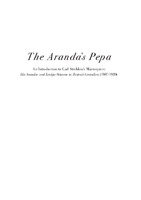The Aranda’s Pepa
An introduction to Carl Strehlow’s Masterpiece Die Aranda- und Loritja-Stämme in Zentral-Australien (1907-1920)
| dc.contributor.author | Kenny, Anna | |
| dc.date.accessioned | 2014-01-06 00:00:00 | |
| dc.date.accessioned | 2020-04-01T14:49:09Z | |
| dc.date.available | 2020-04-01T14:49:09Z | |
| dc.date.issued | 2013 | |
| dc.identifier | 462762 | |
| dc.identifier | OCN: 849283451 | en_US |
| dc.identifier.uri | http://library.oapen.org/handle/20.500.12657/33507 | |
| dc.description.abstract | "The German missionary Carl Strehlow (1871-1922) had a deep ethnographic interest in Aboriginal Australian cosmology and social life which he documented in his 7 volume work Die Aranda- und Loritja-Stämme in Zentral-Australien that remains unpublished in English. In 1913, Marcel Mauss called his collection of sacred songs and myths, an Australian Rig Veda. This immensely rich corpus, based on a lifetime on the central Australian frontier, is barely known in the English-speaking world and is the last great body of early Australian ethnography that has not yet been built into the world of Australian anthropology and its intellectual history. The German psychological and hermeneutic traditions of anthropology that developed outside of a British-Australian intellectual world were alternatives to 19th century British scientism. The intellectual roots of early German anthropology reached back to Johann Gottfried Herder (1744-1803), the founder of German historical particularism, who rejected the concept of race as well as the French dogma of the uniform development of civilisation. Instead he recognised unique sets of values transmitted through history and maintained that cultures had to be viewed in terms of their own development and purpose. Thus, humanity was made up of a great diversity of ways of life, language being one of its main manifestations. It is this tradition that led to a concept of cultures in the plural." | |
| dc.language | English | |
| dc.subject.classification | thema EDItEUR::N History and Archaeology::NH History::NHM Australasian and Pacific history | en_US |
| dc.subject.other | australian ethnography | |
| dc.subject.other | carl strehlow | |
| dc.subject.other | Anthropology | |
| dc.subject.other | Arrernte language | |
| dc.subject.other | Arrernte people | |
| dc.subject.other | Central Australia | |
| dc.subject.other | Dreaming (Australian Aboriginal art) | |
| dc.subject.other | Ted Strehlow | |
| dc.subject.other | Totem | |
| dc.title | The Aranda’s Pepa | |
| dc.title.alternative | An introduction to Carl Strehlow’s Masterpiece Die Aranda- und Loritja-Stämme in Zentral-Australien (1907-1920) | |
| dc.type | book | |
| oapen.identifier.doi | 10.26530/OAPEN_462762 | |
| oapen.relation.isPublishedBy | ddc8cc3f-dd57-40ef-b8d5-06f839686b71 | |
| oapen.pages | 310 | |
| oapen.place.publication | Canberra | |
| oapen.remark.public | Relevant Wikipedia pages: Anthropology - https://en.wikipedia.org/wiki/Anthropology; Arrernte language - https://en.wikipedia.org/wiki/Arrernte_language; Arrernte people - https://en.wikipedia.org/wiki/Arrernte_people; Carl Strehlow - https://en.wikipedia.org/wiki/Carl_Strehlow; Central Australia - https://en.wikipedia.org/wiki/Central_Australia; Dreaming (Australian Aboriginal art) - https://en.wikipedia.org/wiki/Dreaming_(Australian_Aboriginal_art); Ethnography - https://en.wikipedia.org/wiki/Ethnography; Strehlow - https://en.wikipedia.org/wiki/Strehlow; Ted Strehlow - https://en.wikipedia.org/wiki/Ted_Strehlow; Totem - https://en.wikipedia.org/wiki/Totem |

